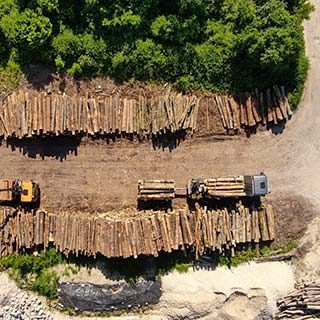We discuss how regenerative agricultural practices go beyond ‘sustainable’.
Key points
- Intensive farming methods have led to nutrient depletion and damage in the health of soil globally.
- Regenerative practices enhance the fertility of soil, reducing the need for fertilisers used in farming and the negative impacts that agriculture has had on the environment.
- With an increased focus on agricultural sustainability, we see opportunities for companies offering solutions such as precision technology or nature-based products.
In recent years we have seen an exponential increase in the focus on sustainability, from consumer brands to investment products to government initiatives. With this has also come a rise in greenwashing, by which sustainability or environmental credentials are misleading or exaggerated. We are now seeing growing importance being placed on going beyond ‘sustainable’, and more specifically on regeneration, which earlier this year was discussed at the dialogue to the UN Food System Summit on mobilising food system change with private sector leadership.1 The philosophy underpinning this concept is that we shift our thinking from simply how we can continue to extract and consume at a rate which can be maintained, to how we can begin to restore and regenerate the natural environment upon which we are so dependent. Given the current levels of damage and depletion to our natural world and capital, some view restoration as essential.
The need for regenerative agriculture
The aim of regenerative agriculture is to restore soil health, which owing to global intensive farming methods has been damaged and depleted of nutrients. As soil is degraded, this negatively affects agricultural yields until eventually soil is no longer fertile and is unable to sustain agriculture. To put this into context, in 2015, the Food and Agriculture Organization of the United Nations (UN FAO) suggested that we have just 60 years of harvests left,2 although there are questions surrounding the accuracy of this estimate and whether it is overstated.3 More recently, we have seen indications that Spain will launch a strategy to combat desertification – necessary given that 20% of its land has already been degraded to the point that it is infertile owing to destructive mining and farming practices.4 A shift to regenerative practices will instead promote a more holistic approach, focusing on what is put into the ground, rather than solely on what comes out of it.
There is evidence that regenerative practices can play an important role in enhancing soil fertility, including boosting the organic matter content, which is vital to its health. Enhanced fertility may reduce the reliance of farmers on certain chemical fertilisers, which, in turn, can significantly decrease carbon footprints and costs, as well as minimise the negative impact from agriculture on water quality in local areas. It is also thought that regenerative practices can increase the water-holding capacity of soil, therefore potentially mitigating the impacts of flooding and drought, both of which may become more prevalent and severe on account of physical changes in our climate. There are even suggestions that these methods could improve the ability of soil to sequester carbon, although there are significant challenges in measuring this. At present, it may be a stretch to say that regenerative agriculture can reduce our impact on climate change; however, it appears that it can deliver reductions in agricultural emissions and improve resiliency to climate risk.
What do regenerative agricultural practices look like?
There are various core components of regenerative agriculture. First, crop rotation is essential – some farms may have crop-rotation cycles lasting ten years or more, and some even integrate animal management, which involves using animals to eat the crops previously on the land, thereby never leaving the soil uncovered and providing a level of protection. Next, regenerative farms should not use tillage – a common process of preparing land for planting, involving the turning and disruption of soil. This process can have negative consequences, including the acceleration of surface run-off and soil erosion, as well as returning stored carbon dioxide back into the atmosphere, and thus is incompatible with regenerative practices.
Interestingly, regenerative practices do not come with strict chemical or fertiliser standards, as in the case of organic farming, meaning their application is far less prescriptive. While there are risks associated with open interpretations and a lack of enforcement, this also presents opportunities. For example, for a farm moving from conventional to organic standards there is a three-year transition period – this can be difficult for farmers to navigate as chemical substances cannot be used, and yields may be negatively affected as a result. This may be off-putting, or, perversely, it may encourage new land to be converted to agriculture, resulting in further deforestation and environmental disruption. With regenerative methods, however, farmers are able to use more discretion during this transition period, and therefore there is not the same incentive to use new land. Again, the focus with regenerative agriculture is to maximise soil health, which tends to mean severely reducing chemical inputs, bringing environmental benefits, reduced costs, and often higher yields over the longer term.
In a world where environmental concerns and regulations are rapidly increasing, we expect to see increased scrutiny on the sustainability of our agricultural system. With this, we envisage a transition to more sustainable practices to better manage the environmental impacts, from climate change to biodiversity. Moreover, given the extent to which we exceed current planetary boundaries in the production of food, drastic changes are required. Complex supply chains will have to adapt, while companies offering solutions such as precision technology or nature-based products may be well placed to facilitate this.
Sources:
3. Do we only have 60 harvests left?, Our World in Data, 14 January 2021
4. Spain counts cost of agribusiness in rising desertification, FT.com, 24 August 2021
This is a financial promotion. These opinions should not be construed as investment or other advice and are subject to change. This material is for information purposes only. This material is for professional investors only. Any reference to a specific security, country or sector should not be construed as a recommendation to buy or sell investments in those securities, countries or sectors. Please note that holdings and positioning are subject to change without notice. Newton manages a variety of investment strategies. Whether and how ESG considerations are assessed or integrated into Newton’s strategies depends on the asset classes and/or the particular strategy involved, as well as the research and investment approach of each Newton firm. ESG may not be considered for each individual investment and, where ESG is considered, other attributes of an investment may outweigh ESG considerations when making investment decisions.
Important information
This material is for Australian wholesale clients only and is not intended for distribution to, nor should it be relied upon by, retail clients. This information has not been prepared to take into account the investment objectives, financial objectives or particular needs of any particular person. Before making an investment decision you should carefully consider, with or without the assistance of a financial adviser, whether such an investment strategy is appropriate in light of your particular investment needs, objectives and financial circumstances.
Newton Investment Management Limited is exempt from the requirement to hold an Australian financial services licence in respect of the financial services it provides to wholesale clients in Australia and is authorised and regulated by the Financial Conduct Authority of the UK under UK laws, which differ from Australian laws.
Newton Investment Management Limited (Newton) is authorised and regulated in the UK by the Financial Conduct Authority (FCA), 12 Endeavour Square, London, E20 1JN. Newton is providing financial services to wholesale clients in Australia in reliance on ASIC Corporations (Repeal and Transitional) Instrument 2016/396, a copy of which is on the website of the Australian Securities and Investments Commission, www.asic.gov.au. The instrument exempts entities that are authorised and regulated in the UK by the FCA, such as Newton, from the need to hold an Australian financial services license under the Corporations Act 2001 for certain financial services provided to Australian wholesale clients on certain conditions. Financial services provided by Newton are regulated by the FCA under the laws and regulatory requirements of the United Kingdom, which are different to the laws applying in Australia.






Comments